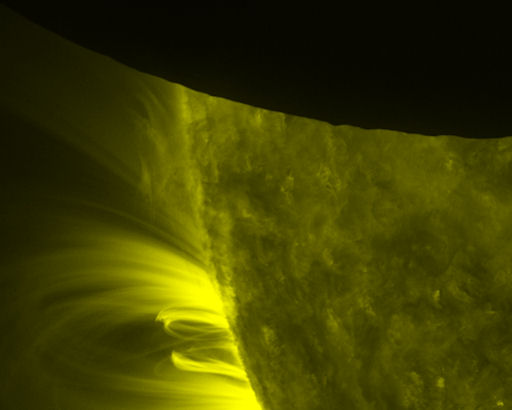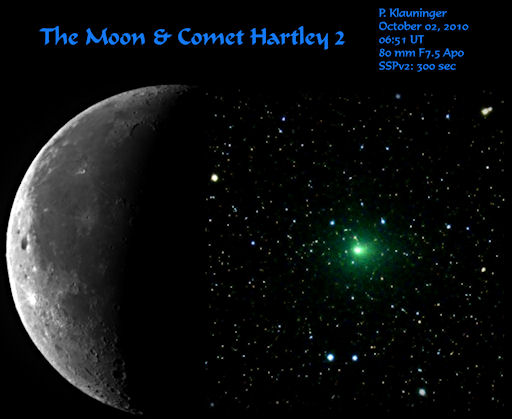iPHONE VS ANDROID! Actually, it doesn't matter which phone you carry. Our cool, new app turns both smartphones into field-tested satellite trackers. Learn more. | | |
ONE YEAR UNTIL THE METEOR OUTBURST: Every year around Oct. 8th, Earth passes through a minefield of dusty debris from Comet Giacobini-Zinner, source of the annual Draconid meteor shower. This year, forecasters expect Earth to narrowly miss several of the debris streams, resulting in no appreciable display for 2010. Next year, however, could be different. On Oct. 8, 2011, Earth will have a near head-on collision with a tendril of dust, setting off a strong outburst of as many as 750 meteors per hour. People in Europe, Africa and the Middle East will have a front-row seat for what could be the strongest shower since the Leonid storms a decade ago. Mark your calendar and, meanwhile, follow these links for more information: Draconid forecasts; sky map; history;
SDO SEES MOUNTAINS ON THE MOON: Yesterday, Oct. 7th, NASA's Solar Dynamics Observatory observed its first lunar transit when the new Moon passed directly between the spacecraft and the sun. SDO's 16 megapixel cameras recorded the event in detail, revealing jagged lunar mountains backlit by solar plasma:

Beyond the novely of observing a such an event from space, these images have practical value to the SDO science team. Karel Schrijver of Lockheed-Martin's Solar and Astrophysics Lab explains: "The very sharp edge of the lunar limb allows us to measure the in-orbit characteristics of the telescope--e.g., light diffraction on optics and filter support grids. Once these are characterized, we can use that information to correct our data for instrumental effects and sharpen up the images to even more detail."
Ralph Seguin, also of Lockheed-Martin, has prepared a movie of the transit which shows the Moon interrupting an eruption on the sun's northwestern horizon. Watch it again. Did you notice the brief blackout near the beginning of the movie? That was the Earth passing in front of the sun just before the Moon did--a double solar eclipse!
COMET HARTLEY UPDATE: As comet 103P/Hartley 2 approaches Earth for an 11-million-mile close encounter on Oct. 20th, it grows bigger and bigger in backyard telescopes. The comet's beautiful green atmosphere now subtends an angle approximately equal to a lunar sea:

Paul Klauninger of Marathon, Ontario, took the picture on Oct. 2nd using a 3-inch refracting telescope. "I photographed the Moon with the same set-up and placed it beside the comet for scale," he says. "In a five minute exposure the comet appears bright green and 7-8 arcminutes across."
Most observers agree that the comet is not yet visible to the naked eye, but may be found using binoculars. Tonight the comet is located a mere 1o from the photogenic Double Cluster in Perseus. Details and a sky map are available from from Sky & Telescope.
more images: from John Buonomo of Billerica, MA; from Nick Howes of Cherhill, Wiltshire, UK; from Pete Lawrence of Selsey, West Sussex, UK; from Paul Evans of Larne, Northern Ireland; from Mike Holloway of Van Buren, Arkansas; from Saied Bahrami Nejad of Kerman, Iran; from Håkon Dahle of Fjellhamar, Norway; from P-M Hedén of Vallenuna, Sweden; from Francisco A. Rodriguez of Cabreja Mountain Observatory, Canary Islands; from John Stetson of Portland, Maine; from Masa Nakamura of Mito, Ibaraki, Japan; from Bill McMullen of Clarence-Rockland, Ontario;
Sept. 2010 Northern Lights Gallery
[previous Septembers: 2009, 2008, 2007, 2006, 2005, 2004, 2002, 2001, 2000]
Potentially Hazardous Asteroids (
PHAs) are space rocks larger than approximately 100m that can come closer to Earth than 0.05 AU. None of the known PHAs is on a collision course with our planet, although astronomers are finding
new ones all the time.
On October 8, 2010 there were 1149 potentially hazardous asteroids.
Notes: LD means "Lunar Distance." 1 LD = 384,401 km, the distance between Earth and the Moon. 1 LD also equals 0.00256 AU. MAG is the visual magnitude of the asteroid on the date of closest approach. | | The official U.S. government space weather bureau |
| | The first place to look for information about sundogs, pillars, rainbows and related phenomena. |
| | Researchers call it a "Hubble for the sun." SDO is the most advanced solar observatory ever. |
| | 3D views of the sun from NASA's Solar and Terrestrial Relations Observatory |
| | Realtime and archival images of the Sun from SOHO. |
| | from the NOAA Space Environment Center |
| | from the National Solar Data Analysis Center |

